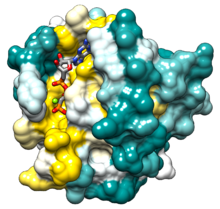
Back عائلة راس Arabic Ras (protein) Czech G-Protein Ras German Ras Spanish Protéine Ras French Ras HE Ras (proteina) Italian Rasタンパク質 Japanese Ras (eiwit) Dutch Proteínas RAS Portuguese
 | |||||||||
| Identifiers | |||||||||
|---|---|---|---|---|---|---|---|---|---|
| Symbol | Ras | ||||||||
| Pfam | PF00071 | ||||||||
| InterPro | IPR020849 | ||||||||
| PROSITE | PDOC00017 | ||||||||
| SCOP2 | 5p21 / SCOPe / SUPFAM | ||||||||
| CDD | cd04138 | ||||||||
| |||||||||
Ras, from "Rat sarcoma virus", is a family of related proteins that are expressed in all animal cell lineages and organs. All Ras protein family members belong to a class of protein called small GTPase, and are involved in transmitting signals within cells (cellular signal transduction). Ras is the prototypical member of the Ras superfamily of proteins, which are all related in three-dimensional structure and regulate diverse cell behaviours.
When Ras is 'switched on' by incoming signals, it subsequently switches on other proteins, which ultimately turn on genes involved in cell growth, differentiation, and survival. Mutations in Ras genes can lead to the production of permanently activated Ras proteins, which can cause unintended and overactive signaling inside the cell, even in the absence of incoming signals.
Because these signals result in cell growth and division, overactive Ras signaling can ultimately lead to cancer.[1] The three Ras genes in humans (HRAS, KRAS, and NRAS) are the most common oncogenes in human cancer; mutations that permanently activate Ras are found in 20 to 25% of all human tumors and up to 90% in certain types of cancer (e.g., pancreatic cancer).[2] For this reason, Ras inhibitors are being studied as a treatment for cancer and other diseases with Ras overexpression.
- ^ Goodsell DS (1999). "The molecular perspective: the ras oncogene". The Oncologist. 4 (3): 263–4. doi:10.1634/theoncologist.4-3-263. PMID 10394594.
- ^ Downward J (January 2003). "Targeting RAS signalling pathways in cancer therapy". Nature Reviews. Cancer. 3 (1): 11–22. doi:10.1038/nrc969. PMID 12509763. S2CID 43074411.